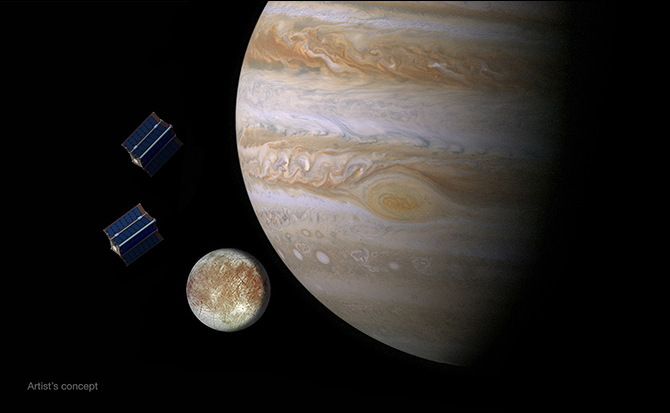Tiny Cubesats May Hitchhike on Mission to Europa

NASA’s Jet Propulsion Laboratory (JPL) in Pasadena, Calif., has selected proposals from 10 universities to begin investigating the possible use of cubesats as auxiliary components to missions to Europa and beyond.
PHOTOS: Top 10 Places To Find Alien Life
Cubesats are small, low cost space probes that can be used to collect scientific data by themselves or part of a “flock.” They have been used extensively in the low-Earth orbit, providing a low-cost means for universities and institutions to carry out experiments in this microgravity environment. As cubesat technology is maturing, so does the scope of their application.
So, as NASA steps up its plans for the Europa Clipper concept to visit the icy Jupiter moon, JPL has asked for cubesat proposals from universities that could complement the primary Clipper payload. As we have a mission going to Europa, why not attach some cubesats for the ride?
NASA has outlined some key science objectives these axillary cubesats should be able to carry out, including “reconnaissance for future landing sites, gravity fields, magnetic fields, atmospheric and plume science, and radiation measurements.”
PHOTO: Dazzling New View of Europa’s Frozen Red Veins
“We’ve seen some innovative and quite creative surprises among the CubeSat ideas submitted by these universities,” said Barry Goldstein, pre-project manager for the Europa Clipper mission. “Using CubeSats for planetary exploration is just now becoming possible, so we want to explore how a future mission to Europa might take advantage of them.”
Get the Space.com Newsletter
Breaking space news, the latest updates on rocket launches, skywatching events and more!
The chosen proposals have been awarded $25,000 each to develop their cubesat concepts to be included in the study, which is expected in the summer of 2015.
Europa is known to possess a sub-surface ocean of liquid water protected by a thick icy shell. As we learn more and more about this little world, our fascination with its life-giving potential is only amplified.
ANALYSIS: Possible Europa Tectonics Could be Boon for Alien Life
We now know that, combined with the oceans of water, nutrients are actively cycling to and from the surface. The icy surface appears to have plate tectonics. Also, scientists believe there’s an abundance of oxygen in the ocean that’s heated by the tidal squishing of Europa’s orbit around Jupiter.
All of these factors point to a possibly habitable world where it has been hypothesized that multicellular life could thrive. But to test this hypothesis, we need to start sending missions to Europa so a close-up picture of its life-giving potential may be formulated — a mission that could be accelerated by the introduction of hitchhiking cubesats to the next big NASA missions to Jovian orbit.
This article was provided by Discovery News.
Join our Space Forums to keep talking space on the latest missions, night sky and more! And if you have a news tip, correction or comment, let us know at: community@space.com.
Ian O'Neill is a media relations specialist at NASA's Jet Propulsion Laboratory (JPL) in Southern California. Prior to joining JPL, he served as editor for the Astronomical Society of the Pacific‘s Mercury magazine and Mercury Online and contributed articles to a number of other publications, including Space.com, Space.com, Live Science, HISTORY.com, Scientific American. Ian holds a Ph.D in solar physics and a master's degree in planetary and space physics.









